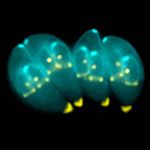| Question
|
Answer
|
Article
|
| True or False: Both trans-stadial and trans-ovarian transmission can occur in Babesia species
|
|
Link to Answer Article
|
| What are the recognisable features of small Babesia species and give and example
|
- Peripheral nucleus
- Obtuse angle
- B. divergens
|
Link to Answer Article
|
| What are the recognisable features of large Babesia species and give and example
|
- Central nucleus
- Acute angle
- B. major
|
Link to Answer Article
|
| What are the predisposing features to Babesia infection?
|
- Susceptible animals introduced into an infected area
- Infected ticks introduced into a clean area
- Infected cattle introduced into an area with clean ticks
- Temporary reduction in the tick population decreasing the transmission rate (causing enzootic instability)
- Infected are transported or stressed in other ways, e.g. parturition
|
Link to Answer Article
|
| What are the different vectors for Babesia species?
|
- Ixodes ricinus for B. divergens
- Haemaphysalis for B. major
- Boophilus for B. bovis and B. bigemina
- Dermacentor and Rhipicephalus for B. canis
|
Link to Answer Article
|
| What species are the natural vectors for Cytauxzoon?
|
|
span title="Answer article">Link to Answer Article
|
| Where do schizonts of Cytauxzoon felis develop?
|
|
span title="Answer article">Link to Answer Article
|
| What is the main condition caused by Theileria parva?
|
|
span title="Answer article">Link to Answer Article
|
| What is the main condition caused by Theileria parva and what is the intermediate host?
|
- East Coast Fever
- Rhipicephalus appendiculatus
|
span title="Answer article">Link to Answer Article
|
| What is the pathogenesis of Theileria parva infections?
|
- Proliferation in the lymphoblasts
- Proliferation in the local lymph node followed by spread throughout the body
- Lymphocyte depletion
|
span title="Answer article">Link to Answer Article
|
| What are the clinical signs of Theileria parva infection?
|
- Pyreia
- Enlarged local lymph node
- Loss of condition
|
span title="Answer article">Link to Answer Article
|
